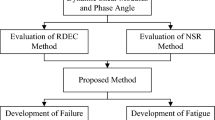Abstract
The original asphalt binder Superpave specification criteria for fatigue, G*sinδ, has received considerable criticism as a specification requirement. A time sweep using the dynamic shear rheometer (DSR) has been proposed as an alternative test method for the Superpave specification. The “modulus versus number of cycles” relationships generated in the time sweep test have the appearance of typical fatigue curves. In this paper, the data was examined with respect to its validity as measure of fatigue.
Special attention was given to parameters that affect or could be confounded with “true” fatigue response: apparent fatigue can generate phenomena susceptible to interfere with the fatigue behavior:
-
- Initial value of the complex modulus of the material. Behaviour in repeated shear depends markedly on the initial stiffness of the binder. If the initial stiffness is low, damage can occur as a result of plastic flow at the outer edge of the asphalt binder.
-
- The influence of the rest periods at different time of the test.
-
- The drop of the modulus at the beginning of the curves.
-
- Steric hardening occurring with time, apparently even during loading, may have some effect on fatigue like when the time sweep is applied over an extended period of time.
Binder type: this procedure showed significant differences in the behavior of various modified binders.
Résumé
Le critère original G*sin δ, sur la fatigue des liants dans les spécifications Superpave est aujourd'hui très fortement remis en question. Un essai rhéologique de balayage dans le temps employant le rhéomètre à cisaillement dynamique (DSR) a été proposé comme méthode d'essai alternative. L'évolution du module de rigidité ainsi obtenue en fonction du nombre de cycles a l'apparence d'une courbe de fatigue classique. Dans cet article, les données ont été étudiées au regard de leur validité pour mesurer la fatigue.
Une attention particulière a été donnée aux paramètres qui affectent ou pourraient être confondus avec une réponse en fatigue vraie. Une fatigue apparente peut en effet générer des phénomènes susceptibles d'interférer avec le comportement en fatigue:
-
- La valuer initiale du module complexe du matériau. Le comportement sous cisaillement répété en dépend beaucoup. Si cette rigidité est trop faible, un endommagement peut se produire par suite d'un écoulement plastique du liant à la circonférence de l'échantillon.
-
- L'influence de périodes de repos à différents moments de l'essai.
-
- La chute du module au début des courbes.
-
- Le durcissement stérique qui se produit en fonction du temps, même sous chargement, peut avoir des effets sur la fatigue lorsque le balayage est appliqué pendant des temps extrêmement longs.
-
- La nature du liant: cette procédure a montré des comportements significativement différents pour des bitumes modifies variés.
Similar content being viewed by others
References
Anderson, D.A. and Kennedy, T.W., ‘Development of SHRP binder specification’,Journal of AAPT 62 (1993).
Bahia, H., Zhai, H., Bonnetti, K. and Kose, S., ‘Non-linear viscoelastic and fatigue properties of bitumen’,Journal of AAPT 68 (1999).
Anderson, D.A., Le Hir, M.Y., Marasteanu, M., Planche, J-P., Martin, D. and Gauthier, G., ‘Evaluation of fatigue criteria for asphalt binder’, Transportation Research Record, 1766 (2001) 48–56.
Soenen, H. and Eckmann, B., ‘Fatigue testing of bituminous binders with a dynamic shear rheometer’, Proceedings of the 2nd Eurasphalt and Eurobitume Congress, Barcelona, 2000.
American Association of State Highway and Transportation Offices MP-1-98, ‘Standard Specifications for Performance Asphalt Binder’.
Keentok, M., ‘Edge fracture in rheometry’, PhD thesis, Department of Mechanical and Mechatronic Engineering, University of Sydney (1997).
Keentok, M. and Xue, S., ‘Edge fracture in cone-plate and parallel plate flows’,Rheological Acta 38 (1999) 321–348.
Di Benedetto, H., Soltani, M.A. and Chaverot, P., ‘Fatigue damage for bituminous mixtures: a pertinent approach’,Journal of AAPT (1996).
Author information
Authors and Affiliations
Additional information
Editorial Note Presented at the 6th International RILEM Symposium on Performance Testing and Evaluation of Bituminous Materials (PTEBM'03), held on 14th–16th April 2003, in Zurich, Switzerland, this paper was selected as an outstanding communication and peer-reviewed by the Scientific Committee of the JournalMaterials and Structures.
Rights and permissions
About this article
Cite this article
Planche, J.P., Anderson, D.A., Gauthier, G. et al. Evaluation of fatigue properties of bituminous binders. Mat. Struct. 37, 356–359 (2004). https://doi.org/10.1007/BF02481683
Received:
Accepted:
Issue Date:
DOI: https://doi.org/10.1007/BF02481683




